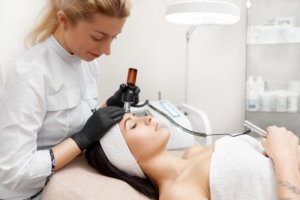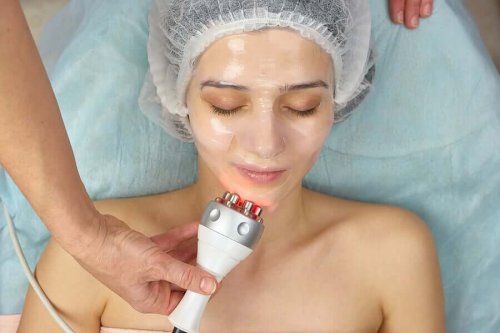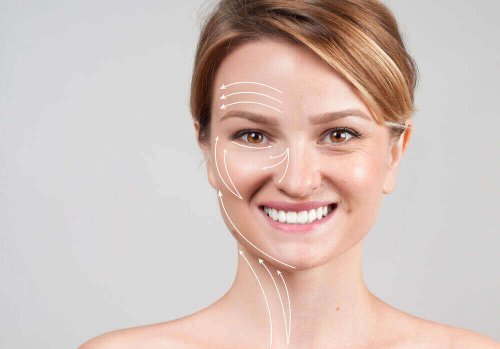What Are the Benefits of Facial Radio-Frequency Skin Tightening?


Written and verified by the doctor Leonardo Biolatto
Both doctors and patients talk about the benefits of facial radio-frequency skin tightening. Although it also has its detractors, the fact is that the technique has advanced a lot in recent times.
While cosmetic surgery is a different approach, this technique has become its competition. As a non-invasive technique, it’s cheaper and yields results in a short time.
Often, it’s called a non-surgical facelift, although this isn’t an exact description. Unlike surgical techniques, it doesn’t require anesthesia and doesn’t constitute the expected side effects of a bigger procedure.
This technique uses energy as heat. RF devices emit energy that penetrates the dermis to stimulate collagen production and regeneration.
It achieves the desired effect because the heat induces fibroblasts, a type of cell present in the skin, to produce new collagen. It can be used on almost any part of the body. There are techniques for the neck, buttocks, and abdomen.
The benefits of radio-frequency skin tightening are notorious in facial application. The patient will require more than one session, and probably at least six.
Radio-frequency devices
The benefits of facial radio-frequency skin tightening have been shown with different pieces of equipment. They can be massagers, toners, or stimulators, and they all act in the same way.
Before conducting the sessions, it’s essential for the skin to be clean. There can be no traces of make-up or any other substance that can hinder the effects of the heat energy.
The professional spreads a conductive gel over the skin. In other words, a substance that allows the passage of energy. The apparatus of choice is positioned over the gel and the professional starts moving it around the area.
Sometimes, facial radio-frequency skin tightening is combined with hyaluronic acid to boost its benefits. However, this isn’t the most common way of doing it.
There are three radio-frequency systems:
- Monopolar. This targets adipose tissue present in deep dermis layers.
- Bipolar. This acts on the surface layers of the skin.
- Tripolar. This combines monopolar and bipolar, stimulating collagen and elastin production and removing fat. Today, it’s the most recommended system, due to its efficacy.

Keep reading: How To Stimulate Your Body’s Collagen Production
Side effects and contraindications
The side effects of facial radio-frequency skin tightening are related to the heat transmitted to the skin. Although it isn’t a painful technique, it can swell and irritate the dermis. In more extreme cases, it can cause bruising that subsequently disappears. However, this isn’t common.
Some countries have reported changes in the conductivity of the facial and trigeminal nerve after the sessions. This led to a more serious establishment of the usage and clear specifications of those who shouldn’t use it.
Thus, here are the contraindications of facial radio-frequency skin tightening, which were internationally agreed upon:
- Firstly, pregnancy and lactation. The adipocytes (fat cells) removed through the technique travel through the lymphatic system and can reach the embryo or the baby that the woman is breastfeeding.
- Oncologic patients. In general, oncologists recommend waiting until five years after remission.
- Pacemakers. The heat radiated by the appliances can alter pacemaker functioning.
- Finally, patients with serious heart problems. Heat energy causes vasodilation and the removed fat circulates through the blood. Both situations are counterproductive to a heart patient. If you still want to undergo facial radio-frequency skin tightening, you should assess the benefits and risks with a cardiologist.

Find out more here: What Face Wrinkles Mean and How to Prevent Them
The benefits of facial radio-frequency skin tightening
Experts worldwide are conducting more and more scientific studies to verify the benefits of facial RF. As of yet, experts have proven its collagen regeneration effects. With new collagen, the skin regains firmness and turgor, reducing wrinkles.
Caloric stimulation also increases circulation on the areas it’s applied. Not only blood circulation, but also lymphatic, allowing the drainage of waste fluids and cells.
In purely medical and mathematical terms, studies showed:
- Brow lift up to 1 mm after three months of treatment.
- Nasolabial fold improvement and reduction of wrinkles in 50% of treated patients.
- Increased cheek contour in 60% of patients.
User satisfaction is high. In general, those who underwent RF sessions believe they saw benefits.
Whatever the case, medical consultation is important before starting. In addition, be sure to get the treatment from a professional.
All cited sources were thoroughly reviewed by our team to ensure their quality, reliability, currency, and validity. The bibliography of this article was considered reliable and of academic or scientific accuracy.
- Mayoral F. A. Skin Tightening With a Combined Unipolar and Bipolar Radiofrecuency Device. Journal of Drugs in Dermatology. 2007.
- Fernández, R. Rodríguez, and M. Mayo Ávila. “La radiofrecuencia contra el envejecimiento de la piel.” Cuestiones de fisioterapia: revista universitaria de información e investigación en Fisioterapia 34 (2007): 70-74.
- Pumarino Santofimia, R. García, and A. Sanchez Olaso. “Láser, luz pulsada, radiofrecuencia y otras fuentes de energía:¿ complemento ocasional a la Cirugía Plástica?.” Cirugía Plástica Ibero-Latinoamericana 34.1 (2008).
This text is provided for informational purposes only and does not replace consultation with a professional. If in doubt, consult your specialist.








